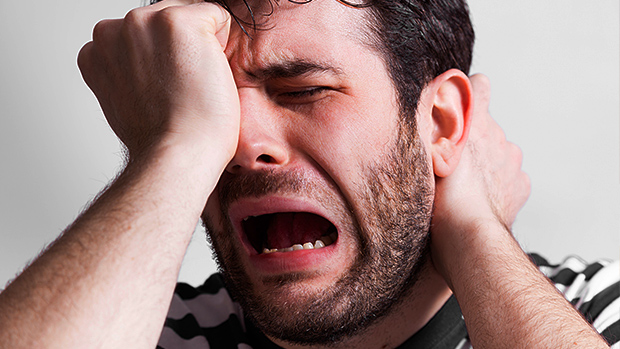When your dad was your age, it was probably easier for him to build muscle and burn body fat than it is for you. Does that annoy you? It should.
We've dumped 85,000 chemicals into our environment since World War II. Why should you care? All that environmental stuff is for tree-hugging hippies, right? Well, not quite. You see, certain chemicals and toxins act like a sledgehammer to the balls.
Your balls.
"Strength coaches around the world are finding that it's harder today for their athletes to pack on mass than it was 30 years ago," notes Coach Charles Poliquin.
The cause? Many point the finger of blame at environmental toxins. Anything that affects testosterone will affect your ability to build muscle, burn body fat, and get strong.
These toxins have a huge effect on the human endocrine system. The average sperm count fell from 113 million per millilitre in 1940 to 66 million in 1990. In addition, the definition of a "normal" sperm count fell from 60 million per millilitre to 20 million in the same period. (1)
A survey of 1,350 sperm donors in Paris found a decline in sperm counts by around 2% each year over the past 23 years, with younger men having the poorest quality semen. (2, 3, 4)
You don't have to look far to confirm this either. I bet you know someone who's having trouble conceiving. And have you noticed the increasing amount of infertility clinics around?
The normal level of testosterone has been reduced by the medical community as well. They simply decided to make a new norm since everyone's testosterone levels are lower than they were 50 years ago.
Take note here: They're not dropping the number because it was too high to begin with. Our numbers today are just consistently that much lower!
The most obvious thing you can do is avoid exposure to toxic chemicals in the first place, but you need to know where to look.
T-lowering toxins can show up where you least expect. For example, Bisphenol A (BPA) is in the receipts you get from a checkout register, and unfortunately, the skin does a great job of absorbing it.
Clearly, you're not going to be able to avoid all the toxins; there are just too many. But you can avoid a great deal of them.

When talking about toxins or toxicity, you'll always hear someone say, "It's only harmful if it's excessive. Even water can be a toxic if it's used in lethal amounts!"
Regulating agencies around the world use the argument that only excess doses lead to toxicity. But when it comes to BPA, don't consider it a toxin. Consider it a hormone.
Any hormone can change the balance of the endocrine system. The hormone BPA best represents is a nasty form of estrogen. Dosing with smaller amounts just doesn't work for BPA.
According to Scientific American, BPA was first synthesised in 1891. It came into the use of synthetic estrogens in the 1930s. It wasn't until it was combined with phosgene (used during World War I as a toxic gas) and other compounds that BPA produced a shatter-proof plastic. (6)
Some suggest BPA was used as a replacement hormone for estrogen, but when the plastics and manufacturing industry found out about its ability to harden plastics, they bought the patent.
Scientists are now pointing out that the only studies which prove BPA's safety are the ones produced by the industry itself. It's also important to consider that the FDA accepts safety studies conducted by the industry. In other words, the fox is guarding the hen house.
Researchers estimate that BPA generates 100 million US dollars per hour, so you can understand why the industry is producing studies to protect BPA.
The Enemy's Worse than You Think
BPA acts as an estrogen, but with two differences:
- It's foreign to the body.
- It's more harmful than natural estrogens.
Xeno-estrogens do all the things that we don't want. Think of it as the complete opposite of injecting testosterone. Xeno-estrogens decrease testosterone and increase estrogens. Researchers have also linked it to insulin resistance. (7)
First Things First: Hydrate Smarter
You knew this was coming: Ditch the thin plastic water bottle right now.
You have a number of replacement options:
- Buy a good quality water filter for your home.
- Buy water in a carton.
- Use a BPA-free water bottle from now on.
If you decide to still use cheap plastic water bottles, follow these rules:
- Don't ever heat a plastic water bottle or leave it in the sun.
- Don't re-use it.
To know if BPA is in your bottle, look for a triangle with a 3 or a 7.

If you see a 3 or 7 in the triangle, buy a different product.
Phthalates can be used in virtually anything from your girlfriend's sex toys to your sex toys.

Seriously, phthalates are used in everything: air-fresheners, cosmetics, shampoos, children's toys, and paints. Why the heck is a plasticiser used in air-fresheners and things that smell nice?
Phthalates hold aromas. So that car-freshener you use to hide the smell of your farts is also lowering your testosterone. (Maybe you should just lower the window from now on.)
Phthalates, like BPA, suppress testosterone, increase insulin resistance, and chelate magnesium and zinc. (10, 11) Their impact on zinc and magnesium can have a very negative compounding effect.
An interesting correlation I learned from Mark Schauss, AUTHOR of Achieving Victory Over a Toxic World, is that the explosion of autism occurred simultaneously with the introduction of phthalates in 1970. Dr. Schauss would be the first person to point out that it's not only the phthalates, but also the negative synergetic effect from the mass amount of environmental toxins.
It's not the end of the human race just yet. There are a few supplements that'll protect against environmental enemies:
- Glycine: Glycine has been found to bind with certain toxins so they can be safely excreted. Luckily, glycine is cheap, and a gram a day would be enough for most people.
- Vitamin C: Helps build glutathione and protects against phthalates. Take 3 grams a day. However, the best way to determine vitamin C dose is bowel tolerance.
- Glutamine: Helps build the gut. The healthier the gut, the more it can protect you against incoming toxins. If you have leaky gut syndrome, you could take 5 to 10 grams with each meal or 60 to 80 grams a day. As for a maintenance dose, 20 to 30 grams should do the job.
- Taurine: This is a calming amino acid but also has the ability to activate detoxification pathways. Take this either after a workout or before bed. One to three grams is best.
- Zinc: A critical mineral for testosterone. In fact, 98% of zinc in males is stored in the prostate. Low zinc status can and will affect testosterone production. As for dosing, try 300 mgs per day. Some may benefit from more, especially if they have high copper.
- Antioxidant supplements high in A, E, and D: My favourite way to hit this is to simply use organic butter.
- Resveratrol: This simple polyphenol is anti-estrogenic. Including something like Rez-V™ in your supplement routine would definitely be a good move.
Saunas can detox your system of phthalates. But when using a sauna for detoxification, make sure it's made with screws only, not glues, and the wood isn't from China.
Saunas made with glues leak toxins, which you breathe in. And wood from China is high in metal.
Some of the most toxic chemicals we have today didn't exist 40 years ago, so building muscle is becoming harder because of the chemical soup in which we live.
Vote with your wallet and buy non-toxic chemicals, not because you're a tree-hugger, but because you're serious about getting as ripped as possible.
You can also check out the Environmental Working Group's website to find out which products lower T. The group has studied over 44,000 soaps, shampoos, and lotions.
The more we reject toxic products by not buying them, the stronger the message we send companies. Tell them it's not okay to make products that lower our T.
In the end, building muscle and losing fat is mostly about how you train and what you eat. But if decreasing environmental toxins will make the process faster and easier, then we're crazy for not arming ourselves with the knowledge to fight the testosterone killers.
- The sperm count has been decreasing steadily for many years in Western industrialised countries: Is there an endocrine basis for this decrease? http://www.ispub.com/ostia/index.php?xmlFilePath=journals/iju/vol2n1/sperm.xml
- R.M.Sharpe, Current Evidence- Another DDT Connection, Nature, vol. 375, 15th June 1995
- R.M.Sharpe, J.S.Fisher, M.M.Millar, S.Jobling and J.P.Sumpter, Gestational and lactational exposure of rats to xeno-estrogens results in reduced testicular size and sperm production, Environmental health perspectives vol. 103, Number 12, Dec 95 p.1136-1143
- L.Hunt, The oestrogen jigsaw, The Independent 22nd September 1994
- Carlsen, E., A Giwercman, N Keiding, N Skakkebaek. 1992. Evidence for Decreasing Quality of Semen During Past 50 Years. British Medical Journal 305:609-613
- Just How Harmful Are Bisphenol A Plastics? August 26, 2008 http://www.scientificamerican.com/article.cfm?id=just-how-harmful-are-bisphenol-a-plastics
- The Estrogenic Effect of Bisphenol A Disrupts Pancreatic Cell Function In Vivo and Induces Insulin Resistance
- Secular Decline in Male Reproductive Function: Is Manliness Threatened? http://jcem.endojournals.org/cgi/content/abstract/92/1/196
- A Population-Level Decline in Serum Testosterone Levels in American Men http://jcem.endojournals.org/cgi/content/full/92/1/44
- Concentrations of Urinary Phthalate Metabolites Are Associated with Increased Waist Circumference and Insulin Resistance in Adult U.S. Males
- The Plasticizer Diethylhexyl Phthalate Induces Malformations by Decreasing Fetal Testosterone Synthesis during Sexual Differentiation in the Male Rat
- Achieving Victory Over a Toxic World, Mark Schauss




